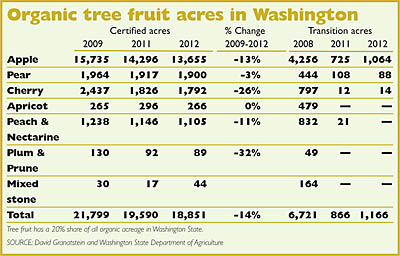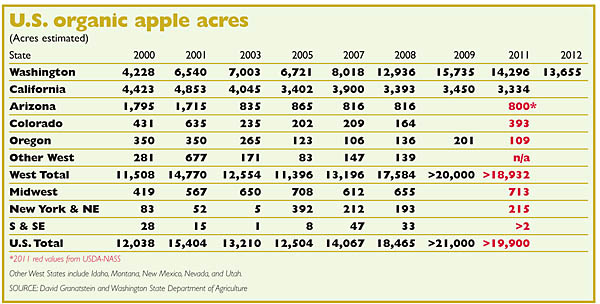The favorable climate and relatively low pest and disease pressure in the arid West have been blessings for organic tree fruit growers. Those conditions explain why more than 95 percent of the nation’s organic apple production comes from Washington, California, Arizona, Colorado, and Oregon. But increasing pest challenges and the potential loss of disease-fighting antibiotics threaten the future of organic tree fruit production, even in the West.
Consumer demand for organic fruits and vegetables is still solid. Organic food sales increased 9 percent in 2011, according to data compiled by David Granatstein, Washington State University’s sustainable agriculture specialist. Fruit and vegetables accounted for almost 40 percent of all organic food sales and 12 percent of all national produce sales in 2010. Organic food sales make up 4 percent of all food sales in the nation.
While growers continue to plant organic tree fruit acreage, the pace is much slower than the rapid expansion of the mid-2000s. Overall, national organic apple acreage was less in 2011 (19,900 acres) than the height of organic plantings in 2009 when more than 21,000 acres were organic, according to statistics from the Washington State Department of Agriculture.
Acreage numbers from WSDA pegged the state’s organic apple acreage at a high of 15,735 acres in 2009. In the same year, there were approximately 1,960 acres of certified organic pears, 2,450 acres of organic cherries, and 1,660 acres of organic stone fruit (apricots, peaches, nectarines, plums, and prunes). For all organic tree fruit in Washington, the total was almost 21,800 acres.
Then came the economic recession, taking the blush off the organic tree fruit market and impacting prices and profitability. By 2012, the state total for organic tree fruit had dropped about 3,000 acres to 18,850, representing a 14 percent decrease in organic tree fruit acreage. Cherries showed the biggest decrease in acreage (26 percent decrease), followed by apples with a 13 percent decrease.
Last year, about 1,100 acres of tree fruit were in transition to be certified as organic, according to WSDA statistics.
 Uncertain future
Uncertain future
Organic production and plantings of apples, pears, and cherries in the state have stabilized, says Harold Austin of Zirkle Fruit Company in Selah, Washington. Austin is director of orchard administration and oversees product and compliance for Zirkle’s 2,000-plus acres of certified organic apples, pears, cherries, and blueberries. “There’s been a slight increase in organic acreage in the last year, but not significant,” he said.
But Austin is worried about the future of organic tree fruit production, particularly for pears, cherries, and blueberries. The National Organic Standards Board, which approves use of materials for organic production, is considering curtailment in 2014 of the use of two key antibiotics to control fireblight—oxytetracycline and streptomycin. Additionally, emerging pests, like spotted wing drosophila and the brown marmorated stinkbug, are putting pressure on organic producers.
Austin, who is a member of the NOSB, said that if the board carries out its proposed antibiotic expiration for October 2014 (which it was to consider during its April meeting), organic pear growers would be hit especially hard. Although there are a few organically approved fireblight alternatives to antibiotics, he said they tend to be more effective on apples and less so on pears. One promising biological yeast that has shown control of fireblight is Blossom Protect. But research trials are ongoing as scientists learn how it works in commercial orchards and under different environmental conditions.
Invasive pests
The spotted wing drosophila, first found in California and Florida in 2008, has spread throughout the United States and is now established in all major stone-fruit-producing states, including Washington, Oregon, California, and Michigan. The fruit fly has an extensive host list that includes, cherries, peaches, nectarines, plums, berries, and grapes.
“Everyone is very concerned about spotted wing drosophila because there are not many organic products that can effectively control it,” Austin said. “We know populations of spotted wing drosophila are increasing. We can probably expect more pressure this summer because of the mild winter we just had. It’s going to be a very difficult pest to control in organic blueberries and cherries.”
Organic cherry growers were able to overcome problems from the Western cherry fruit fly with GF-120, an attractant and bait spray that was approved for organic use and has become a standard control. However, the GF-120 bait does not control spotted wing drosophila.
 Spotted wing drosophila can produce a new generation every two weeks, which means that pest pressure increases as summer progresses. Based on Washington State trap catches from the past few years, it appears that cherries in late-growing districts will be at greater risk than earlier-maturing cherries.
Spotted wing drosophila can produce a new generation every two weeks, which means that pest pressure increases as summer progresses. Based on Washington State trap catches from the past few years, it appears that cherries in late-growing districts will be at greater risk than earlier-maturing cherries.
Later varieties of blueberries are also the most susceptible to damage from the tiny fruit fly. The pest has resulted in economic damage in cane and bush berries throughout the United States.
Another invasive pest that could negatively affect organic tree fruit production is the brown marmorated stinkbug. Tree fruit growers on the East Coast have already battled this pest that is slowly making its way to all parts of the country. The stinkbug has been found in Hood River, Oregon, and one adult has been found in Yakima, Washington. Most believe it’s just a matter of time before the pest moves into commercial orchards. Organic fruit growers have available pyrethrums and an insecticide containing azadirachtin to help manage the brown marmorated stinkbug.
“We’ve been in a really good period for organic production, but these pest issues will need to be reckoned with as we move forward,” Austin said. “How much more can we grow the organic market in tree fruit? Until we figure out how to control spotted wing drosophila and other pests, especially in cherries and blueberries, we will likely see diminished organic acreage.
“We’ve got solid demand for organic products, but every year we are seeing increasing challenges that the industry must encounter.”

Leave A Comment